Last Updated on August 15, 2022
What is Shuttering?
Before diving into the types of shuttering (formwork) used in construction, let’s have an understanding of what shuttering is. Shuttering is utilized as a temporary mould into which concrete is poured to get the required concrete structural shape on the construction site. Shuttering concrete is done to give the concrete a form while it sets, preventing leaks, cracks, or uneven surfaces.
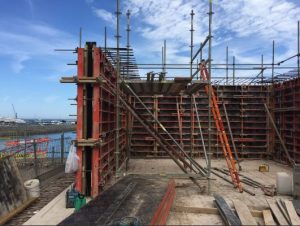
Long before the concrete is even poured, the process of concrete shuttering begins. The placement of the formwork elements must first be determined by a plan, which is typically created by creating a blueprint. The type of shuttering to be employed should then be determined.
It will probably take many workers to complete the formwork installation on larger projects because this is not a quick process. To ensure that the formwork is installed correctly and that all angles are tight, formwork must be inspected and double-checked. This will stop concrete from flowing out of spaces between formwork panels and help to ensure that all of the surfaces of concrete will be smooth and straight when concrete is set. After the setting time of concrete, the shuttering panels should be removed (formwork striking) and cleaned so that they can be used again for subsequent projects.
Common Shuttering Materials
Shuttering materials mainly include timber, steel, plywood, aluminum, fabric, plastic and some insulation material. Formwork is essential in concrete construction. It must be strong enough to withstand all of the loads present during casting and then keep its shape as the concrete hardens. In a construction site, surveying should be made for formworks to be placed on correct elevations. We’ll see the types of shuttering in this article below.
Main Types of Shuttering Used in Construction
1. Plywood Shuttering
Plywood formworks are types of shuttering that has been highly densified and has a smooth film on both sides of its face. It is mostly used in construction to put up the ceiling and keeping the cement. Densified means that the shuttering plywood contains at least nine different layers of core veneers that have been compressed using a high-pressure machine at an exceptionally high temperature.
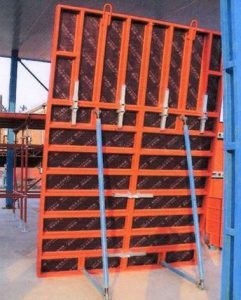
The shuttering plywood is generally used to provide the basis for drains, ceilings, pillars, walls and roads. The concrete mixture is poured on top of this plywood platform, giving the concrete any shape requested by the designer.
2. Steel Shuttering
Steel formworks are types of shuttering that are temporary construction elements used to hold concrete while it hardens. Steel is an ideal material for formwork because it will never bend or warp if designed appropriately while pouring concrete. Steel shuttering is capable of storing a big volume of concrete. Steel is brittle, making it unsuitable for bonding with concrete. Steel plates may be stacked to build higher constructions.
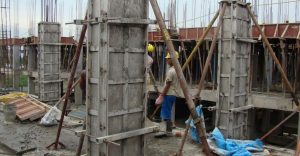
Steel formworks can interlock to each other and this can be used to keep the panels together for increased stability. The disadvantage of steel formworks is its weight: the plates might be difficult to move into place, which means heavy construction machinery may be required to properly place the panels.
3. Plastic Shuttering
Plastic formworks are types of shuttering which are interlocking, light-weight structures that can be used more than 100 times. It may be utilized in standard concrete construction. This sort of shuttering is becoming increasingly popular for similar designs and major housing projects.
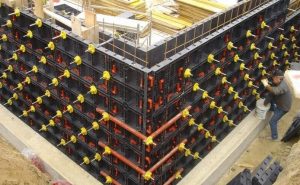
When compared to alternative materials for concrete formworks, the use of plastic formworks for concrete construction offers various advantages such as durability, affordability, and flexibility. It is made of a special grade of plastic so that neither put materials cling to it nor chemical reactions occur between poured materials and the plastic shuttering, resulting in no patch on the surface of the reinforced concrete component. Water or freshly placed concrete leakages from different places of the formwork are avoided thanks to the formwork’s precise interlocking system. Furthermore, it is the most labor-friendly system since it is easy to setup it and it also has much less weight when compared to other forms of formwork systems.
4. Timber Shuttering
Timber formworks are types of shuttering which are a low-cost and easily accessible option. Traditional wooden formwork is constructed on-site from timber. Wooden shuttering is easy to make, but it takes time for larger constructions. Wood shuttering works better than all other types of shuttering in small-scale projects. Plywood and timber shuttering material have a short life cycle, but they are nonetheless widely utilized in locations where the cost of labor is cheaper than the cost of acquiring reusable form work material. It is the most flexible sort of form work. Even in large projects when other forms of formwork are utilized, it is applied in difficult sections.
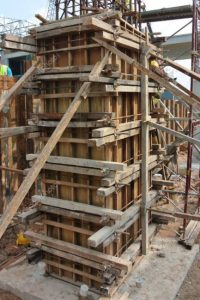
In other words, timber shuttering is utilized in concrete constructions to provide structural support for molds. It can be used to create forms for concrete pouring or to support large panels to create a bigger formwork installation. Depending on the materials used, the timber may be reusable in another projects, especially if used carefully. Hardware stores may have a variety of timber suited for this use, and manufactured wood products especially intended for use in formwork may also be available.
5. Tunnel Formwork
Tunnel formworks are types of shuttering that enables the contractor to cast walls and slabs in a single operation throughout the daily cycle. It is recognized as a modern form of construction because it combines the speed, quality, and precision of factory/off-site manufacturing with the flexibility and economics of in-situ construction. The great result is a cellular reinforced structure with sufficiently high-quality surfaces that require very minor finishing for direct decorating, while the end walls and facades are simply finished with thermally insulated components that may be clad as needed.
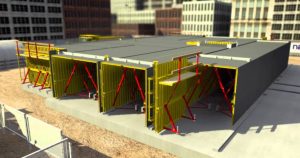
The system produces an efficient load-bearing structure that can be used in a wide range of applications. It is especially useful in projects requiring repeating cellular construction, such as residential towers, hotels, student dormitories, prisons and barracks.
6. Aluminium Shuttering
Aluminium formworks are types of shuttering that is a construction system used to construct cast-in-place concrete structures. It is also a scheduling and control system for other construction works such as steel reinforcement, mechanical and electrical conduits and concrete placement.
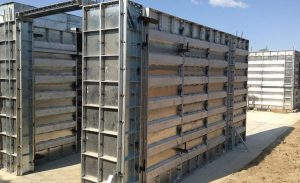
The system is quick, easy to use, versatile, and cost effective. It is distinctive in that it precisely shapes all of the concrete in a construction, including walls, beams, columns, floor slabs, staircases, balconies, and different decorative features, in line with the design.
7. Fabric Shuttering
Fabric formworks, also known as flexible formwork, are types of shuttering that are made of fabric. This technique employs high-strength and lightweight fabric sheets that are meant to arrange to the fluidity of concrete and produce distinctive architectural shapes.
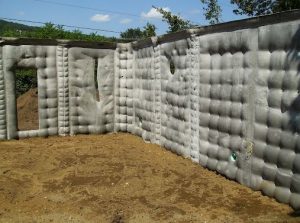
This style of formwork requires less concrete than rigid systems, resulting in cost savings. It is a new technique in the shuttering industry that is well suited for irregular and complicated designs. Fabric formwork can be utilized in both precast and cast-in-place applications. It has many benefits over traditional formwork technology and allows for creativity in architectural and structural concrete members.
8. Permanent Insulated Shuttering
Permanent insulated formwork is a building technology that employs lightweight formwork which is made of an insulation material to support concrete walls while they are being cast in-situ and is then kept in place as insulation.
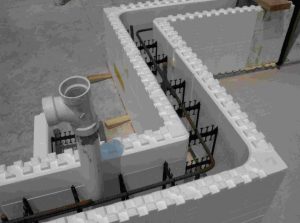
Permanent insulated concrete formwork includes twin-walled expanded insulation panels that are well-stacked to form a permanent formwork that holds ready-mixed concrete for the walls. The permanent insulated formwork is left in situ to ensure that the final building’s walls are completely thermally insulated. It also creates a consistent surface that is suitable for most finishes and appropriate coating systems to be applied directly. Many insulated concrete formwork systems include a flooring system as well.
9. Stay in Place Formwork
Stay in place formwork is meant to stay in place after the concrete has hardened, providing axial and shear supports. Prefabricated and fiber-reinforced plastic forms are used to construct this formwork on-site. It is mostly utilized in piers and columns, as well as providing corrosion resistance and resistance to various sorts of environmental damage.
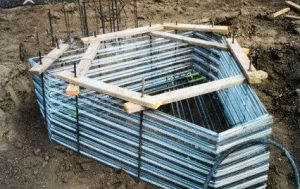
Coffor, a type of stay in place formwork, is a structural stay-in-place formwork technique that is used to construct reinforced concrete walls. It is made up of two rib lath filtration grids that are strengthened by C profiles. Connectors made of articulated rebar link the grids together.
Concrete is poured into Coffor once Coffor is anchored to the ground. While the fluid concrete becomes semi-solid, the excess water drains through the grids. The pressure on the grids is reduced when the excess water is removed. Coffor remains inside the building and serves as a kind of reinforcement.
Advantages and Disadvantages of Different Types of Shuttering
1. Timber Shuttering
Advantages
- Timber may be simply cut to any shape that is desired.
- Formwork made of wood may be simply removed.
- In cold climates, timber has a high thermal resistance, which helps to avoid concrete degradation.
- Timber is light in weight and easy to work with.
Disadvantages
- These formworks are limited in their usage and can’t be utilized for a long period.
- Wood with a high moisture content, as well as wet concrete, will shrink, resulting in leaking of cup open joints and grout.
- If the wood is dry, it will absorb moisture from the wet concrete, thereby weakening the resultant concrete member.
2. Plastic Shuttering
Advantages
- Damage to the formwork can be easily repaired.
- They are particularly useful for complex shapes and differences.
- It is simple to cut and nail with woodworking.
- It has a lighter weight.
Disadvantages
- They have a limited load carrying capacity.
- Plastics are damaged by heat.
- It is costly.
3. Steel Shuttering
Advantages
- They are simple to repair.
- They are more long-lasting than wood formwork.
- These formworks are highly durable and load-bearing.
- It can be used in larger quantities.
- It has a similar form and surface.
Disadvantages
- They are more costly than wood.
- They are restricted in size and shape.
- Handling is tough as a result of the increased weight.
4. Plywood Shuttering
Advantages
- It has a higher number of reuses than timber.
- Plywood may also be used to create curved formworks.
- Plywood is strong, long-lasting, and low in weight.
- Plywood may also be simply cut to the appropriate size.
- It provides a smooth surface finish.
- There are very large plywood sheets available, making formwork production faster and easier.
Disadvantages
- Thin plywood sheets cannot support the weight of concrete and may bend out if adequate thickness is not given.
- It is more expensive than timber.
5. Aluminum Shuttering
Advantages
- It may be reused several times.
- Aluminum formwork may be used to construct monolithic crack-free structures.
- Simple to assemble and disassemble.
- Because of its small weight, it is easily handled.
Disadvantages
- When aluminum formwork is employed, architectural changes are not possible.
- The lighter portions may deflect when the load approaches its maximum limit.
6. Tunnel Formwork
Advantages
- The construction of a box-type building is resistant to horizontal stresses such as earthquakes and cyclones.
- Tunnel formwork provides high quality finishing, eliminating the need for any sort of plastering work.
- It is cost-effective for large-scale building of several similar modular units, such as residences, hostels, dormitories and hospitals.
- Tunnel shuttering requires less slab cycle time, resulting in faster and more reliable construction.
Disadvantages
- In comparison to traditional systems, a skilled labor force is required.
- Due to the requirements of crane by each block, equipment expenses are considerably higher.
- If the project is small, the investment cost of the formwork system is higher.
What are tie rods in formwork?
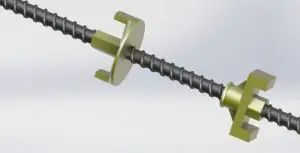
Tie rods are temporary members of shuttering. Their main job is to hold the formwork together during concrete pouring operations so that it can be secured. In order to prevent either side from bulging under the weight of the wet concrete, they clamp the formwork.
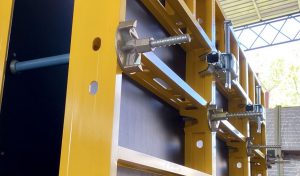
When the concrete is being poured, it flows over and around the tie rod, leaving a hole when the rods are taken out after the concrete has dried and hardened. After the rod is removed, these holes are normally filled, but over time, ground movement and freeze-thaw cycles can cause the filling to lose its effectiveness.
Types of shuttering have been explained in this article. Hope you enjoyed it!

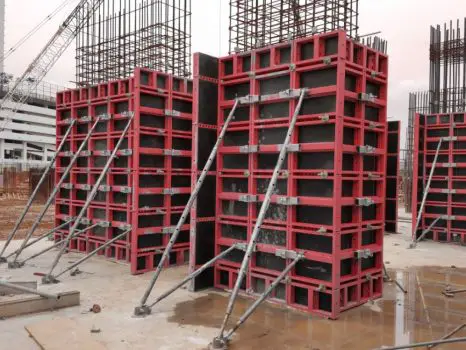
Pingback: Differences Between Civil and Structural Engineering ❘ techyildiz
Pingback: Types of Slabs Used in Construction Projects | techyildiz
Pingback: Main Types of Beams Used in Construction | techyildiz